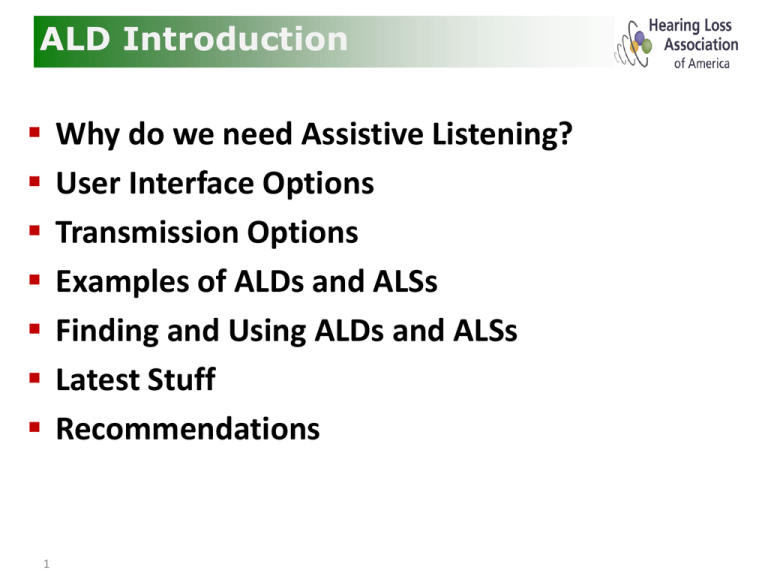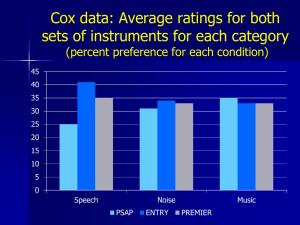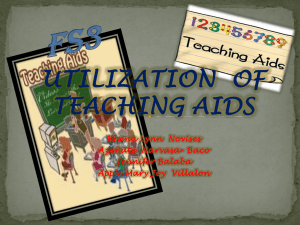PowerPoint file.
advertisement

ALD Introduction Why do we need Assistive Listening? User Interface Options Transmission Options Examples of ALDs and ALSs Finding and Using ALDs and ALSs Latest Stuff Recommendations 1 Why We Need ALDs Hearing Aids and CIs Best in Quiet and Close Not so good at a distance Not so good in noise Not so good when sounds bounce around ALDs can solve those “Big Three” problems 2 Bring the sound you want to hear right to your ears Eliminate or at least reduce the noise Eliminate the reverberation (bounced sound) Minimize the loss of signal from conversion Make a HUGE difference in how much you understand The Big Three Distance Double the distance; QUADRUPLE the loss Varies with frequency (highs don’t “travel” well) Noise What you want to hear is easy to lose in the din The “signal to noise” ratio matters Reverberation Even without noise, sound you want to hear gets “spread out” as it bounces around the room Hear the “straight line” first, but then delayed versions of the same thing at lower volume. 3 Reverberation Reverberation and echos reduce speech intelligibility 4 Hearing Your Best The TV from Across the Room On the Phone In the car Your Friends at Dinner At the Museum At the Movies At a Play In a Noisy Restaurant Other Audio Sources Radios Music Players iPods 5 Hearing Aids and CIs Hearing aids and CIs have microphones for Input microphones hear everything Background noise Reverberation Poor quality signal after distance. Some hearing aids and CIs have other input options 6 Other Input Paths The following input paths can be used instead of or in addition to the hearing aid or CI’s microphones. Magnetic Analog Telecoil Digital Near Field Magnet Input (NFMI) Direct Audio Input (DAI) FM Receivers Boot Embedded By having access to these alternatives, you can choose how to hear best in every situation. Get your audiologist to set up your programs and explain how to use them 7 Interface Options Headphones (no Hearing Aids or Cis or telecoils) Headphones (with telecoils in Hearing Aids or Cis) Earbuds (usually only works without hearing aids) Neckloops Standard Analog (to telecoils) Near Field Magnetic Interface (NFMI) … digital induction Silhouettes (to telecoils) FM Boots (to DAI) Embedded Patch cord (to DAI) 8 Personal Amplifiers Pocketalker (or similar) Wired Connect Via Neckloop Silhouettes DAI Headphones ~$140 9 Personal FM Solutions • Transmit sound from transmitter to receiver by FM radio. • Directional Microphones • You choice of Interface 10 Personal IR Solutions • Transmit sound from transmitter to receiver by Infrared light. • Directional Microphones • Some let you choose interface • Mostly for TV (not very portable) 11 Personal Loops • Room loops – TV – Computer • Chairpad loops • Tableloops 12 Bluetooth • Bluetooth uses a digital signal to communicate between a pendant and paired audio sources • It can be “two-way” so it can work with phones both in and out • Transmission/receiving done in pairs; not a “broadcast” • Digitally encoded, so it’s private • Your Bluetooth device can “remember” several different pairings and reconnect automatically • Only connects with one paired device at a time 13 Bluetooth • So far, there are no Bluetooth Hearing Aid or CIs • Bluetooth loopsets can connect you to phones (and TVs, iPods, Tablets, Computers and remote mics) • Bluetooth to Device – Standard Bluetooth • • • – NFMI • Oticon • • • • Phonak • 14 Standard Analog Magnetic to Hearing Aids/Cis Advantages • Cheap • Not Proprietary Disadvantages • Bilateral but Mono • Possible EMI (interference) Bluetooth to Device NFMI Magnetic to Hearing Aids/CIs Advantages • Some are True Stereo • No Interference Disadvantages • More Expensive • Proprietary Bluetooth NFMI Bluetooth Analog Bluetooth • Good – – – – Relatively cheap Some are Integrated with remote controls Some are true stereo No Electromagnetic Interferences (unlike regular telecoils) • Possible issues – – – – Short range (maybe 30 ft) NFMI is Proprietary; must match your hearing aids Uses a lot of power (so far) it must be a pendant Processing delay can be more than 25 ms • Ok for phone calls or listening to music or radio • May be distracting if watching TV or other video Systems • Assistive Listening Systems – FM – IR – Loops • Installation – Permanent – Portable • Movies, Auditoriums, Theaters, Stadiums, Churches, Classrooms, 18 Jacks and Plugs • • • • • • • Mono (1 ring, 2 sections) Stereo (2 ring, 3 sections) Cell Phone (3 rings, 4 sections) Stereo to Mono Adaptor Male to Male Adaptor RCA to male 3.5 mm Optical Simple Mic to TV • Place a good mic near the TV • Patch it via wire or your favorite wireless to your ALD of choice – FM – IR – Bluetooth • Use your favorite interface – – – – Headphones Earbuds Neckloop Silhouette(s) • Works, but better to patch directly to the TV Patching to a TV Then with appropriate adaptor to your favorite interface o Bluetooth TV adaptor o FM o InfraRed o Stereo System o Room Loop o Headset May need a stereo/mono adaptor May need different style jack Some newer TVs don’t have “line outs”, but use an Optical audio output. You would need a d/a converter to patch to most ALDs. Finding Systems • Signs – IR – Loops – ALDs • Websites – www.aldlocator.com – www.loopamerica.org – http://www.americanhearingloop.com/hearing-looplocations.html – www.captionfish.com – http://www.hearinglossweb.com/tech/ald/loop/loop.htm 22 Resources • www.ncatp.org • Information • Trial equipment • www.ncdhhs.gov/dsdhh/ • Regional Centers • Equipment Distribution • www.nchearingloss.org • Glossary defines terms • HLAA Conventions • Don’t miss the exhibit area 23 Recommendations • Look for where you could benefit from Assistive Technology. • Consider which technologies meet your needs. • Try out the technology in various situations. • Never buy a hearing aid that doesn’t have standard telecoils • Get your telecoils activated and tuned to your needs. • Learn how to change to the best program for each situation. • Consider other options such as a personal amplifier, Bluetooth, FM or IR • Standard telecoils are NOT obsolete • Some aids have both NFMI and standard telecoils. 24 Latest Stuff • Roger FM (by Phonak but supports most brands) • Pen mic • Clipon mic • Boot or embedded receivers • Cochlear Dynamic FM • For BAHA • For Nucleus CI (soon) • MFi (Made for iPhone) hearing aids • Some direct to aids from several manufacturers • Some to a “gateway” device 25 Questions? • Now I’ll stay as long as you like • Later Email me at steve.barber@earthlink.net 26





